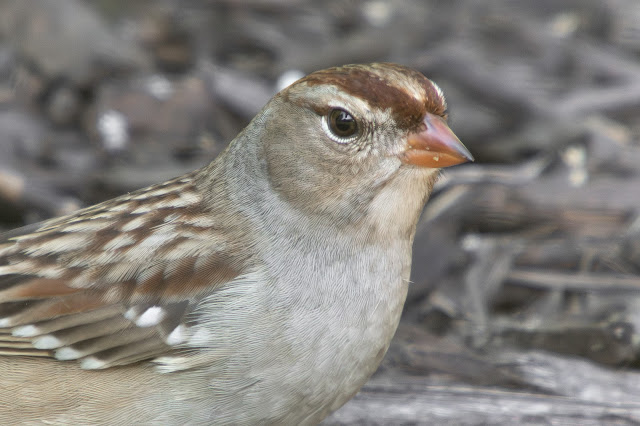Digiscoping w/ the Sony a7III - 03 Nov 2018
I stopped by ProCam in Livonia last evening and picked up a new Sony Alpha a7III camera body. Thanks, Chris (and Robin) for helping to pick out the camera and accessories while I rudely caught up with Jerry Sadowski and Mark Byrnes...
The Sony a7III is a full-frame mirrorless camera that is considered an entry-level camera, but it is anything but. It has been so popular that it sold out within days of its initial offering, and its been 6 months before any new copies would be available to camera enthusiast. While waiting for it to become available there were plenty of reviews to enjoy.
After spending last evening and this morning setting up menus I had a chance to give it a play. Then, Robin and I took a quick run over to Oakwoods Metropark so that I could do a direct comparison with my current digiscoping camera, the Sony Alpha a6300.
The advantage of the full-frame a7III over its smaller cousin is both size of sensor, image quality and noise properties. To compare the two for myself I set both cameras to Aperture priority and ISO Auto between 100 - 6400. The Sony Alpha a7III was paired with my Sony 35mm f/2.8 Sonnar (EFL=35mm) while the Sony a6300 was paired with my Sigma 30mm f/2.8 DN (EFL=45mm).
At ISO 3200 the noise properties are seriously impressive. Being able to shoot 'silently' also allowed me to avoid disturbing the birds so I could fire away at 10 fps while slightly rolling focus to ensure that some frames would be tack-sharp.
The Sony a7III is a serious contender for 2018 Mirrorless Camera of the Year in many circles, and now becomes a serious contender for digiscoping camera of the year, as well!
Tomorrow I get to put it to serious use. A Spotted Redshank was discovered in Ann Arbor today and I hope to get a chance to see and digiscope it tomorrow morning...
The Sony a7III is a full-frame mirrorless camera that is considered an entry-level camera, but it is anything but. It has been so popular that it sold out within days of its initial offering, and its been 6 months before any new copies would be available to camera enthusiast. While waiting for it to become available there were plenty of reviews to enjoy.
After spending last evening and this morning setting up menus I had a chance to give it a play. Then, Robin and I took a quick run over to Oakwoods Metropark so that I could do a direct comparison with my current digiscoping camera, the Sony Alpha a6300.
The advantage of the full-frame a7III over its smaller cousin is both size of sensor, image quality and noise properties. To compare the two for myself I set both cameras to Aperture priority and ISO Auto between 100 - 6400. The Sony Alpha a7III was paired with my Sony 35mm f/2.8 Sonnar (EFL=35mm) while the Sony a6300 was paired with my Sigma 30mm f/2.8 DN (EFL=45mm).
The high-ISO improvement of the Sony a7III is obviously and expectedly better than the a6300 as you can see in the above images. Honestly, I was more surprised at just how good the a6300 is. Most of my digiscoping (shooting 1/1000 sec. at f/2.8) tends to push ISO's to these heights so I'm looking for the any improvement. The full-frame a7III produces cleaner and tinier noise pixels without chroma coloration that tends to show up in the a6300.
I took the above image to compare corner sharpness of the two lenses. The $800 Sonnar on the a7III produced significantly sharper corners compared to the Sigma DN under same shooting conditions. There was also less CA observed with the more expensive full-frame system at right.
In the above image of the log house the Sony a6300 chose 1/15 sec exposure at ISO 100 (left) while the a7III went with a faster shutter speed at the expense of doubling the ISO. This made for a significantly sharper image under auto-focusing conditions.
I then stepped inside the Nature Center and found a dark closet where a canoe was being store. This gave me a chance to test high-ISO conditions. The a7III's built-in camera stabilization helped out significantly by producing a sharper image compared to the smaller a6300. Also note the improved dynamic range of the a7III in the upper right corners of the full images; the a6300 washed out while the a7III resolved nicely the window glare.
So how does the Sony a7III work as a digiscoping camera? I put it to the test when I got home by attaching it to my Digidapter™ and mounting it to the scope. The camera is significantly heavier than the smaller a6300, and slightly beefier feeling, but fit just fine on the Digidapter™. My initial attempts came while trying to shoot the Northern Cardinals in the hedges about 20' away from my position on the deck. Focusing with the scope, then attaching the camera and using the magnification assist allowed me to capture some sharp images of both a female and male Northern Cardinal.
Finally, a Blue Jay, an American Goldfinch, Dark-eyed Junco and Downy Woodpecker made quick appearances and allowed some photos to be taken.
Tomorrow I get to put it to serious use. A Spotted Redshank was discovered in Ann Arbor today and I hope to get a chance to see and digiscope it tomorrow morning...















Comments
Post a Comment